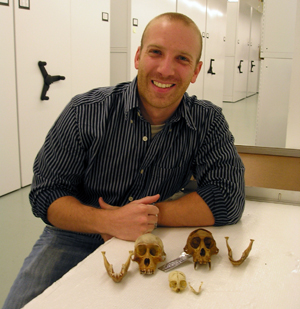Hunter College Anthropology Professor Christopher Gilbert Coauthors the Discovery and Description of a New Species of Monkey
 New York, September 12, 2012 - Hunter College announced today that Christopher C. Gilbert, Ph.D., Assistant Professor in the Department of Anthropology, coauthored the discovery and description of a new species of African monkey in the Democratic Republic of Congo, Cercopithecus lomamiensis, locally known as the "Lesula." The paper was published in the current issue of PLOS ONE.
New York, September 12, 2012 - Hunter College announced today that Christopher C. Gilbert, Ph.D., Assistant Professor in the Department of Anthropology, coauthored the discovery and description of a new species of African monkey in the Democratic Republic of Congo, Cercopithecus lomamiensis, locally known as the "Lesula." The paper was published in the current issue of PLOS ONE.
This is only the second new species of African monkey discovered in the last 28 years. The first Lesula found was a young captive animal seen in a compound in the town of Opala in 2007 by survey teams of the Lukuru Foundation, which was undertaking the first systematic inventories of large mammals of this landscape in the Congo.
Since the first discovery of the Lesula in 2007, a collaboration of scientists from Lukuru Foundation, Hunter College, Florida Atlantic University, New York University, Columbia, Yale University, and the Wildlife Conservation Society were able to locate the Lesula in the wild, determine its genetic and anatomical distinctiveness, and make initial observations of its behavior and ecology. Dr. Gilbert's roles in the discovery were that he performed the anatomical comparisons and analyses of the new species while he was a postdoctoral fellow at Yale, and once he was on board at Hunter, he contributed to the writing and submission of the paper for publication in PLOS ONE. The anatomical analyses were essential in demonstrating that the Lesula is, in fact, a new species of monkey. Along with the genetics and behavioral observations in the field, his results conclusively demonstrate that the Lesula is significantly different from its closest relative, the owl-faced monkey. In terms of its anatomy, he demonstrated numerous features that distinguish the Lesula from the owl-faced monkey, including a much paler face and nose stripe, a blonde/golden mane, a reddish stripe on the lower back, larger orbits, and a number of other small but statistically significant differences in the hard anatomy of the skull and dentition.
"The discovery of a new large mammal, in this day and age, is a rare event. This discovery is significant because it highlights the fact that there are still remote places left in this world that we don't know much about," said Dr. Gilbert. "The Lesula is important in advancing our understanding of African monkey and African mammal evolution."
 The Lesula also highlights the conservation challenges facing many of the planet's remaining areas of biodiversity, says Dr. Gilbert. "The natural world is an amazing place, and we learn new things about the Earth's biodiversity every day. The Lesula highlights a specific region of high biodiversity deep in the heart of the Congo that has not received much attention and is in desperate need of conservation. It would be nice to learn as much as we can about the world's biodiversity before it is gone."
The Lesula also highlights the conservation challenges facing many of the planet's remaining areas of biodiversity, says Dr. Gilbert. "The natural world is an amazing place, and we learn new things about the Earth's biodiversity every day. The Lesula highlights a specific region of high biodiversity deep in the heart of the Congo that has not received much attention and is in desperate need of conservation. It would be nice to learn as much as we can about the world's biodiversity before it is gone."
The Lesula is seriously threatened by uncontrolled commercial bush meat hunting that has expanded into the species' range over the past decade.
"The challenge for conservation now in Congo is to intervene before losses become definitive," according to conservation biologists John and Terese Hart, of the Lukuru Foundation and Yale's Peabody Museum, who led the discovery and documentation of the Lesula. "We are asking people not only to stop hunting in the area that will become a national park, but also to change their hunting behavior and to not hunt the Lesula and other endangered species in the adjoining buffer zones as well. We have seen initial willingness, but there will have to be economic alternatives."
Hunter College President Jennifer Raab said, "We are so proud of the cutting-edge work of physical anthropologist Christopher Gilbert, whose work has led to the discovery of a new species of African monkey-only the second such discovery in 28 years. At Hunter today, we have many talented scientists working on animal behavior and conservation across disciplines like anthropology and psychology. We are committed to supporting a world-class scientific research enterprise at Hunter College, and are thrilled by the exciting breakthroughs that our young scientists like Chris Gilbert are making."
